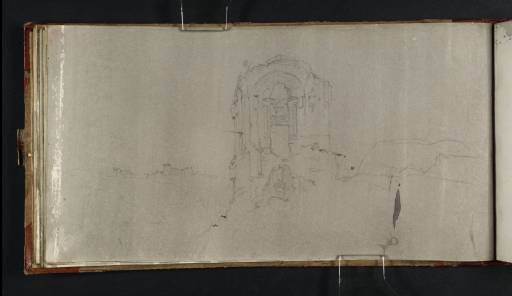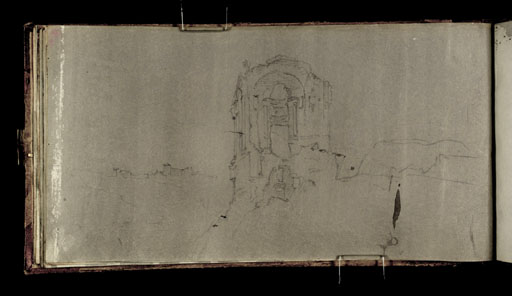Joseph Mallord William Turner The So-Called Sedia del Diavolo, Rome 1819
Image 1 of 2
Joseph Mallord William Turner,
The So-Called Sedia del Diavolo, Rome
1819
Joseph Mallord William Turner 1775–1851
Folio 25 Verso:
The So-Called Sedia del Diavolo, Rome 1819
D16426
Turner Bequest CXC 22 a
Turner Bequest CXC 22 a
Pencil and grey watercolour wash on white wove paper, 130 x 255 mm
Accepted by the nation as part of the Turner Bequest 1856
References
1909
A.J. Finberg, A Complete Inventory of the Drawings of the Turner Bequest, London 1909, vol.I, p.565, as ‘Ruined temple.’.
In addition to the great monuments and buildings of central Rome, Turner recorded a number of noted landmarks found in the northern outskirts of the city such as the Fontana dell’Acqua Acetosa (see the Naples: Rome C. Studies sketchbook, Tate D16138; Turner Bequest CLXXXVII 50), the Torre Lazzaroni (see folio 27, D16442; Turner Bequest CXC 32) and the Ponte Molle (see folio 53, D16475; Turner Bequest CXC 59). The subject of this sketch is the so-called Sedia del Diavolo (Devil’s Chair), a Roman tomb dating from the second or third century which stands in present-day Piazza Callistio, near to the ancient Via Nomentana.1 The brick structure, known today as the tomb of Elio Callistio, is comprised of two storeys and derives its names from the shape suggested by its three surviving walls.2 Its ruined appearance, perched on an area of high ground between the Ponte Nomentano and the Church of Sant’Agnese fuori le mura, represented a picturesque motif for topographical artists.3 Further sketches can be found on folios 1, 26 verso, 39, 42 and 43 (D16399, D16428, D16458, D16462 and D16463; Turner Bequest CXC 5, 23a, 44, 47 and 48) and the tomb can also be seen in relation to the Ponte Nomentano on folios 24 verso and 45 (D16424 and D16465; Turner Bequest CXC 21a and 50). Like many drawings within this sketchbook, the composition has been executed over a washed grey background.
Nicola Moorby
June 2009
Touring club italiano, Roma e Dintorni, 6th edition, Milan 1977, p.319; and Raymond Keaveney, Views of Rome from the Thomas Ashby Collection in the Vatican Library, exhibition catalogue, Smithsonian Institution, Washington 1988, p.242.
See photographs in Oreste Ferrari, Tea Marintelli, Valerie Scott et al., Thomas Ashby: Un Archeologo Fotografa la Campagna Romana Tra ’800 e’900, Rome 1986, p.32, no.10 figs.1–4. See also the on-line photographic archive of Antonio Cederna (1921–1996), http://archivio.archiviocederna.it/xSearch/?query=sedia+del+diavolo , accessed June 2009.
See for example a drawing attributed to Jacques-Françoise Amand (1730–1769), reproduced in Keaveney 1988, no.66, p.243, and an oil painting by Richard Wilson, Strada Nomentana circa 1765–70 (Tate, N00301).
How to cite
Nicola Moorby, ‘The So-Called Sedia del Diavolo, Rome 1819 by Joseph Mallord William Turner’, catalogue entry, June 2009, in David Blayney Brown (ed.), J.M.W. Turner: Sketchbooks, Drawings and Watercolours, Tate Research Publication, December 2012, https://www


